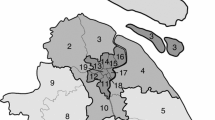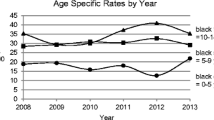Abstract
Background: Scarce information is available about the variation in the incidence of Type 1 diabetes in the Brazilian population in the last decades. Aim: The objective of this study was to assess the long-term trends (1986–2006) in the incidence of Type 1 diabetes in Bauru, São Paulo State, Brazil. Subjects and methods: The annual incidence of Type 1 diabetes (per 100,000 per yr) from 1986 to 2006 was determined in children ≤14 yr of age, using the capture and recapture method. Results: A total of 176 cases were diagnosed in the study population. The overall incidence was 10.4/100,000 with a range of 2.82/100,000 in 1987 to 18.49/100,000 in 2002 representing a 6.56-fold increase within the same population. The estimated incidence, using the capture and recapture method varied from 2.82/100,000 per yr in 1987 to 27.20/100,000 per yr in 2002, representing a 9.6-fold variation. The global pattern of incidence variation was categorized as high (10-19.99/100,000 per yr), and very high (≥20/100,000 per yr) in 71.43% of the study-years. Incidence was slightly higher among females, Caucasians, children in the 5–9 yr of age range and belonging to lower socio-economic classes. Most diagnoses were established during the colder months and/or with higher pluviometric indexes. Conclusions: The incidence of Type 1 diabetes in children is increasing in Bauru, São Paulo State, Brazil, and the global pattern of incidence was classified as high or very high, mainly in the last 10 yr. All Brazilian regions should be involved in the study.
Similar content being viewed by others
References
Familial insulin-dependent diabetes mellitus (IDDM) epidemiology: standardization of data for the DIAMOND Project. The WHO Multinational Project for Childhood Diabetes Group. Bull World Health Organ 1991, 69: 767–77.
Geographic patterns of childhood insulin-dependent diabetes mellitus. Diabetes Epidemiology Research International Group. Diabetes 1988, 37: 1113–9.
Rewers M, LaPorte RE, King H, Tuomilehto J. Trends in the prevalence and incidence of diabetes: insulin-dependent diabetes mellitus in childhood. World Health Stat Q 1990, 41: 179–89.
Green A, Gale EA, Patterson CC. Incidence of childhood-onset insulin-dependent diabetes mellitus: the EURODIAB ACE Study. Lancet 1992, 339: 905–9.
Karvonen M, Tuomilehto J, Libman I, LaPorte R. A review of the recent epidemiological data on the worldwide incidence of type 1 (insulin-dependent) diabetes mellitus. World Health Organization DIAMOND Project Group. Diabetologia 1993, 36: 883–92.
Karvonen M, Pitkäniemi M, Pitkäniemi J, Kohtamäki K, Tajima N, Tuomilehto J. Sex difference in the incidence of insulin-dependent diabetes mellitus: an analysis of the recent epidemiological data: World Health Organization DiaMond Project Group. Diabetes Metab Rev 1997, 13: 275–91.
Karvonen M, Viik-Kajander M, Moltchanova E, Libman I, LaPorte R, Tuomilehto J. Incidence of childhood type 1 diabetes worldwide. Diabetes Mondiale (DiaMond) Project Group. Diabetes Care 2000, 23: 1516–26.
McLarty DG, Swai AB, Kitange HM, et al. Prevalence of diabetes and impaired glucose tolerance in rural Tanzania. Lancet 1989, 1: 871–5.
Hugh-Jones P. Diabetes in Jamaica. Lancet 1955, 269: 891–7.
Glass B, Li CC. The dynamics of racial intermixture: an analysis based on the American Negro. Am J Hum Genet 1953, 5: 1–4.
Mac Donald MJ. Lower frequency of diabetes among hospitalized Negro than white children: theoretical implications. Acta Genet Med Gemellol (Roma) 1975, 24: 119–26.
MacDonald MJ. The frequencies of juvenile diabetes in American blacks and Caucasians are consistent with dominant inheritance. Diabetes 1980, 29: 110–4.
Reitnauer PJ, Go RC, Acton RT, et al. Evidence for genetic admixture as a determinant in the occurrence of insulin-dependent diabetes mellitus in U.S. blacks. Diabetes 1982, 31: 532–7.
Chakraborty R, Kamboh MI, Nwankwo M, Ferrell RE. Caucasian genes in American blacks: new data. Am J Hum Genet 1992, 50: 145–55.
Dahlquist G, Mustonen L. Childhood onset diabetes—time trends and climatological factors. Int J Epidemiol 1994, 23: 1234–41.
Padaiga Z, Tuomilehto J, Karvonen M,et al. Incidence trends in childhood onset IDDM in four countries around the Baltic Sea during 1983–1992. Diabetologia 1977, 40: 187–92.
Helgason T, Danielsen R, Thorsson AV. Incidence and prevalence of type 1 (insulin-dependent) diabetes mellitus in Icelandic children 1970–1989. Diabetologia 1992, 35: 880–3.
Shamis I, Gordon O, Albag Y, Goldsand G, Laron Z. Ethnic differences in the incidence of childhood IDDM in Israel (1965–1993). Marked increase since 1985, especially in Yemenite Jews. Diabetes Care 1997, 20: 504–8.
WHO Multinational Project for Childhood Diabetes. WHO Diamond Project Group. Diabetes Care 1990, 13: 1062–8.
Instituto Brasileiro de Geografia e Estatística-IBGE. http://www.ibge.gov.br (accessed on 03/01/2009).
Wenzel G. Rumo ao coraçao do Brazil. In Pelegrina, GR: Os frutos da terra: Bauru, 1896–1988. São Paulo: Marprint Ed. 1988, 29–58.
Malerbi DA, Franco LJ. Multicenter study of the prevalence of diabetes mellitus and impaired glucose tolerance in the urban Brazilian population aged 30–69 yr: The Brazilian Cooperative Group on the Study of Diabetes Prevalence. Diabetes Care 1992, 15: 1509–16.
Briscoe J. Brazil: The New Challenge of Adult Health. A World Bank Country Study. Washington, DC: The International Bank for Reconstruction and Development/The World Bank, 1990.
Laurenti R, Fonseca LA, da Costa Júnior ML. Diabetes mellitus mortality in the municipality of São Paulo (Brazil). Evolution over a period of 79 years (1900–1978) and analysis of some aspects of the association of causes. Rev Saude Publica 1982, 16: 77–91.
Departamento de Informática do Sistema Único de Saúde-DATA-SUS. http://datasus.gov.br (accessed on 03/01/2009).
Diagnosis and classification of diabetes mellitus. American Diabetes Association. Diabetes Care 2005, 28 (Suppl 1): 37–42.
Graciano MIG, Lehfeld NA, Neves Filho A. Critérios para classificação socio-econômica: elementos de atualização. Serviço Soc Realidade 1999, 8: 109–28.
LaPorte RE, McCarty D, Bruno G, Tajima N, Baba S. Counting diabetes in the next millennium: application of capture-recapture technology. Diabetes Care 1993, 16: 528–34.
Verlato G, Muggeo M. Capture-recapture method in the epidemiology of type 2 diabetes: a contribution from the Verona Diabetes Study. Diabetes Care 2000, 23: 759–64.
Tilling K. Capture-recapture methods: useful or misleading? Int J Epidemiol 2001, 30: 12–4.
Rosner B. Fundamentals of Biostatistics. 5th ed. Boston, MA: Harvard University, Duxbury Press. 2000, 692.
LaPorte RE, Orchard TJ, Kuller LH et al. The Pittsburgh Insulin Dependent Diabetes Mellitus Registry: the relationship of insulin dependent diabetes mellitus incidence to social class. Am J Epidemiol 1981, 114: 379–84.
Patterson CC, Dahlquist G, Soltész G, Green A; EURODIAB ACE Study Group. Europe and Diabetes. Is childhood-onset type I diabetes a wealth-related disease? An ecological analysis of European incidence rates. Diabetologia 2001, 44 (Suppl 3): B9–16.
Instituto de Pesquisas Meteorológicas. Série histórica de parâmetros climáticos entre 1986 e 2006. Accessed on 03/01/2009.
DIAMOND Project Group. Incidence and trends of childhood Type 1 diabetes worldwide 1990–1999. Diabet Med 2006, 23: 857–66.
Padaiga Z, Tuomilehto J, Karvonen M, et al. Seasonal variation in the incidence of type 1 diabetes mellitus during 1983 to 1992 in the countries around the Baltic Sea. Diabet Med 1999, 16: 736–43.
Onkamo P, Väänänen S, Karvonen M, Tuomilehto J. Worldwide increase in incidence of Type I diabetes—the analysis of the data on published incidence trends. Diabetologia 1999, 42: 1395–403.
Patrick SL, Kadohiro JK, Waxman SH, et al. IDDM incidence in a multiracial population: the Hawaii IDDM Registry, 1980–1990. Diabetes Care 1997, 20: 983–7.
Songini M, Loche M, Stabilini M, et al. The incidence of type 1 diabetes is rapidly increasing in Sardinian male army conscripts (Abstract). Diabetologia 1992, 35 (Suppl. 1): A25.
Karvonen M, Jäntti V, Muntoni S,et al. Comparison of the seasonal pattern in the clinical onset of IDDM in Finland and Sardinia. Diabetes Care 1998, 21: 1101–9.
Ramos AJS, Araujo MM, Cavalcante GS, Tejo AM. Incidência do diabetes tipo I em Campina Grande-EBID-Campina Grande, Pb-Brasil. Rev Asoc Latinoam Diab 1995, 3: 82.
Campos JJB, Almeida HGG, Iochida L, Franco LJ. Incidência de diabetes mellitus insulino dependente (Tipo 1) na cidade de Londrina PR-Barsil/Incidence of insulin dependent diabetes mellitus (type 1) in the city of Londrina, Paraná-Brazil. Arq Bras Endocrinol Metabol 1998, 42: 36–44.
Lisbôa HR, Graebin R, Butzke L, Rodrigues CS. Incidence of type 1 diabetes mellitus in Passo Fundo, RS, Brazil. Braz J Med Biol Res 1998, 31: 1553–6.
Cavalli-Sforza L, Menozzi P, Piazza A. Europe: The History and Geography of Human Genes. Princeton, NJ: Princeton University Press. 1994, 268–80.
Holmqvist BM, Lofman O, Samuelsson U. A low incidence of Type 1 diabetes between 1977 and 2001 in south-eastern Sweden in areas with high population density and which are more deprived. Diabet Med 2008, 25: 255–60.
Author information
Authors and Affiliations
Corresponding author
Rights and permissions
About this article
Cite this article
Negrato, C.A., Dias, J.P.L., Teixeira, M.F. et al. Temporal trends in incidence of Type 1 diabetes between 1986 and 2006 in Brazil. J Endocrinol Invest 33, 373–377 (2010). https://doi.org/10.1007/BF03346606
Accepted:
Published:
Issue Date:
DOI: https://doi.org/10.1007/BF03346606




